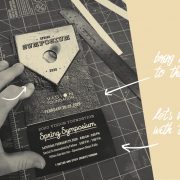Differentiated from the Rest
To be more precise, that is the question organizations often unwittingly face as they seek to stand out in an ever-growing sea of smartly branded products and enterprises. And while the question of differentiation may not seem as existentially vital as Shakespeare’s original soliloquy, the wrong choices may leave your group suffering self-inflicted blows that fortune wouldn’t have dared strike.
Differentiation is no longer a buzzword in marketing and communications circles, it has passed into the less thoughtful realm of cliché. The danger with clichés is that their assumed meaning is often superficial and unhelpful. The “clichéd” definition of differentiation is a simple truncation of the word — to be different.
The unfortunate side effect is that aiming for “different” can lead to inauthentic attempts to stand out among the crowd… often by being louder or bigger or more risqué than the rest. In the 21st century, no matter how “different” you are, if it’s inauthentic you certainly won’t win the day. Worse still, in the long term, different for the sake of difference will dilute your brand and water down your organization’s voice. And, in an ironic twist, these inauthentic attempts at difference often make you quite similar to the rest of the crowd, like a hipster hanging out in a Brooklyn coffee shop.
Differentiation, on the other hand, is a distinct concept. When your organization can be true to itself, and creatively speak from within its voice and personality across a series of mediums, you can truly be differentiated. In the same way that no snowflake is the same, so it also goes with organizations; living up to your unique personality and the special ways you relate to your audience is in fact a simple way to differentiate. Moreover, being authentically differentiated cultivates a trusting relationship with those to whom you relate.
In the end, what does this mean in practice? I recently worked with a nonprofit whose identity is built around honesty in good times and bad. They were crafting a monthly newsletter to report on an initiative they had just launched. Some of the groundwork for the program hadn’t gone as smoothly as they had hoped. As they reported on progress to their donors, they were clear about their struggles. They didn’t include unnecessary details, but were extremely transparent nonetheless. As opposed to scaring donors away, it appears more people than normal read the newsletter. And the response was overwhelmingly positive. They were true to their personality and differentiated from countless other organizational newsletters that mundanely and predictably trumpet flawless performances. Most of all, it appears they deepened the trusting relationship with their audience.
So there it is. Be yourself. Do it creatively. And you will be differentiated from the rest.
Justin is the Managing Director of Non-Profit Accounts for Matt Jensen Marketing.
Read more articles by Justin






